engine TOYOTA SEQUOIA 2021 Owners Manual (in English)
[x] Cancel search | Manufacturer: TOYOTA, Model Year: 2021, Model line: SEQUOIA, Model: TOYOTA SEQUOIA 2021Pages: 59, PDF Size: 7.34 MB
Page 3 of 59
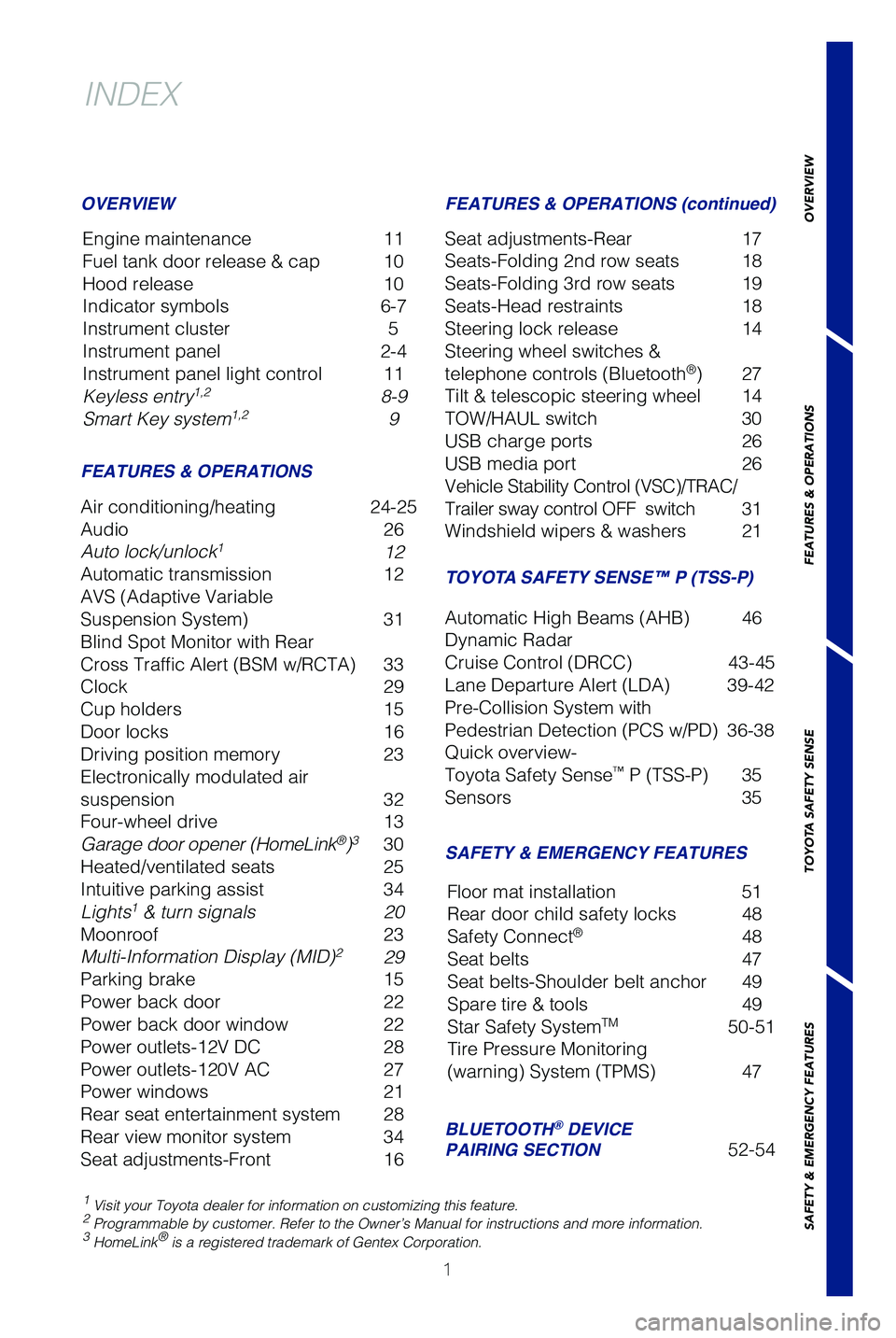
1
1 Visit your Toyota dealer for information on customizing this feature.2 Programmable by customer. Refer to the Owner’s Manual for instructio\
ns and more information.3 HomeLink® is a registered trademark of Gentex Corporation.
INDEX
Engine maintenance 11
Fuel tank door release & cap 10
Hood release 10
Indicator symbols 6-7
Instrument cluster 5
Instrument panel 2-4
Instrument panel light control 11
Keyless entry
1,2 8-9
Smart Key system1,2 9
OVERVIEW
FEATURES & OPERATIONS
Air conditioning/heating 24-25
Audio 26
Auto lock/unlock
1 12
Automatic transmission 12
AVS (Adaptive Variable
Suspension System) 31
Blind Spot Monitor with Rear
Cross Traffic Alert (BSM w/RCTA) 33
Clock 29
Cup holders 15
Door locks 16
Driving position memory 23
Electronically modulated air
suspension 32
Four-wheel drive 13
Garage door opener (HomeLink
®)3 30
Heated/ventilated seats 25
Intuitive parking assist 34
Lights
1 & turn signals 20
Moonroof 23
Multi-Information Display (MID)
2 29
Parking brake 15
Power back door 22
Power back door window 22
Power outlets-12V DC 28
Power outlets-120V AC 27
Power windows 21
Rear seat entertainment system 28
Rear view monitor system 34
Seat adjustments-Front 16
SAFETY & EMERGENCY FEATURES FEATURES & OPERATIONS (continued)
Seat adjustments-Rear 17
Seats-Folding 2nd row seats 18
Seats-Folding 3rd row seats 19
Seats-Head restraints 18
Steering lock release 14
Steering wheel switches &
telephone controls (Bluetooth
®) 27
Tilt & telescopic steering wheel 14
TOW/HAUL switch 30
USB charge ports 26
USB media port 26
Vehicle Stability Control (VSC)/TRAC/
Trailer sway control OFF switch 31
Windshield wipers & washers 21
BLUETOOTH® DEVICE
PAIRING SECTION 52-54
Floor mat installation
51
Rear door child safety locks 48
Safety Connect
® 48
Seat belts 47
Seat belts-Shoulder belt anchor 49
Spare tire & tools 49
Star Safety System
TM 50-51
Tire Pressure Monitoring
(warning) System (TPMS) 47
TOYOTA SAFETY SENSE™ P (TSS-P)
Automatic High Beams (AHB) 46
Dynamic Radar
Cruise Control (DRCC) 43-45
Lane Departure Alert (LDA) 39-42
Pre-Collision System with
Pedestrian Detection (PCS w/PD) 36-38
Quick overview-
Toyota Safety Sense
™ P (TSS-P) 35
Sensors 35
OVERVIEW
FEATURES & OPERATIONS
TOYOTA SAFETY SENSE
SAFETY & EMERGENCY FEATURES
Page 7 of 59
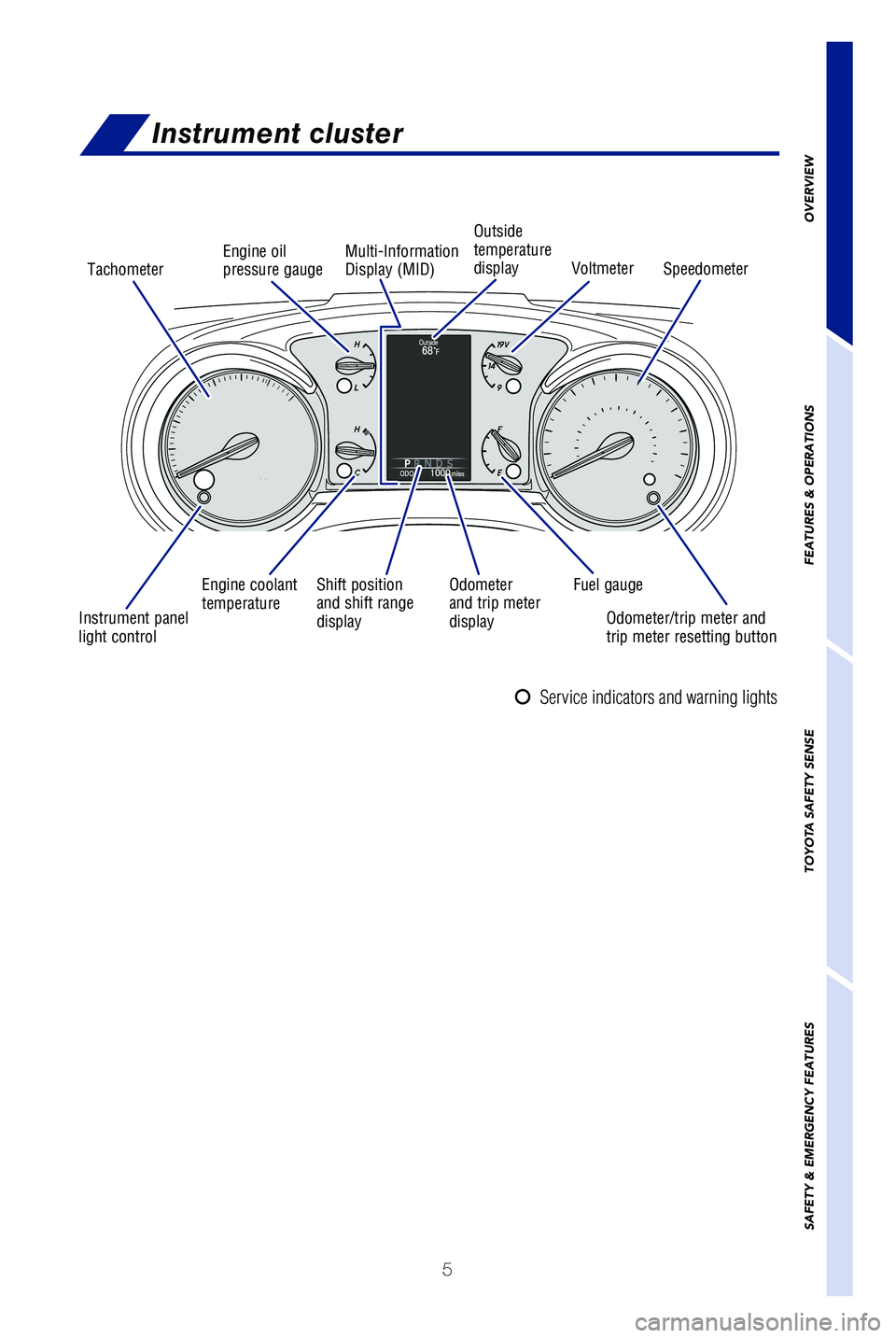
5
Instrument cluster
OVERVIEW
FEATURES & OPERATIONS
TOYOTA SAFETY SENSE
SAFETY & EMERGENCY FEATURES
Multi-Information
Display (MID) Outside
temperature
display
Service indicators and warning lights
Speedometer
Fuel gauge
Odometer
and trip meter
display
Shift position
and shift range
display Voltmeter
Engine oil
pressure gauge
Engine coolant
temperature Odometer/trip meter and
trip meter resetting button
Instrument panel
light control Tachometer
Page 9 of 59
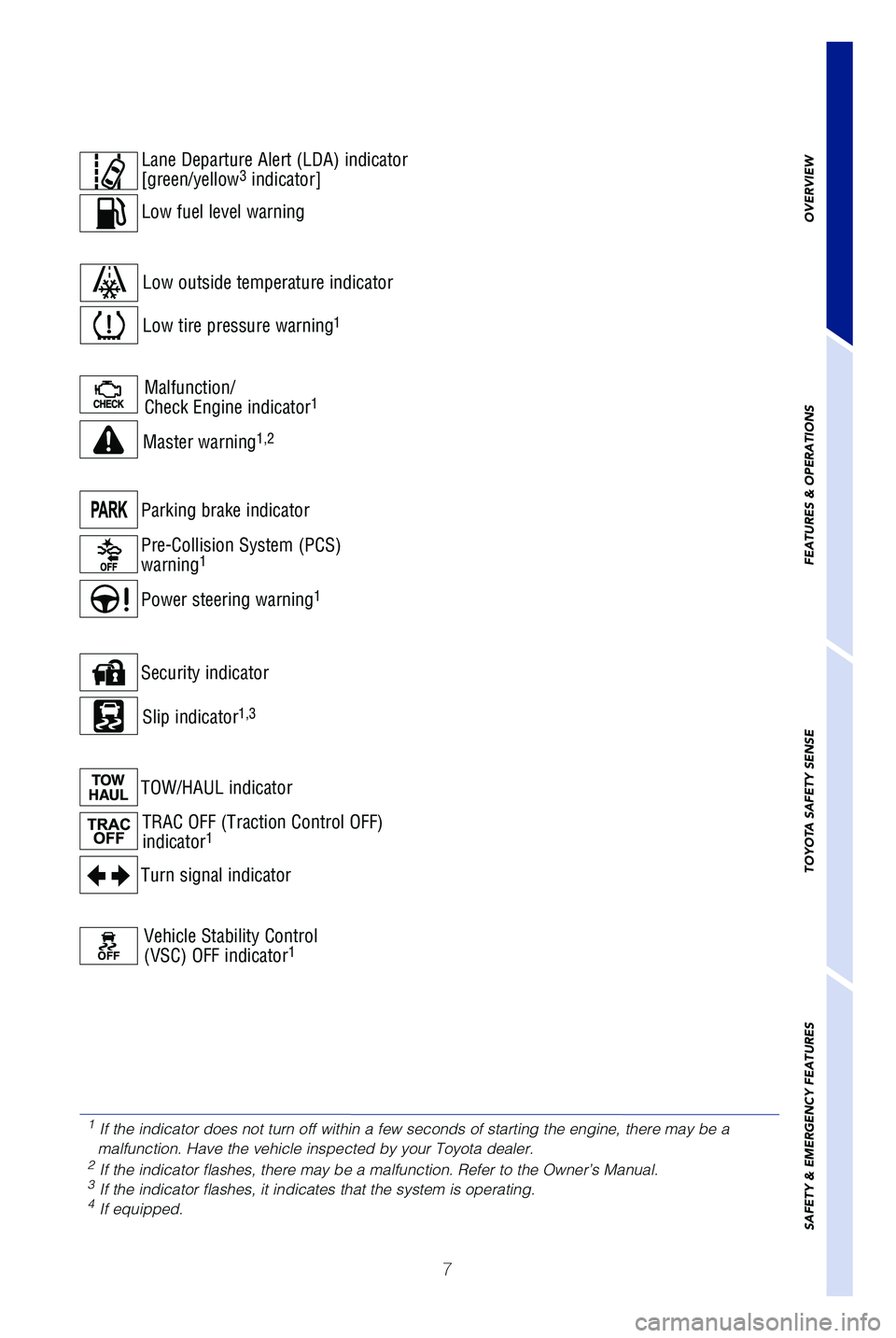
7
Parking brake indicator
Pre-Collision System (PCS)
warning
1
Power steering warning1
Malfunction/
Check Engine indicator1
Master warning1,2
Slip indicator1,3
Turn signal indicator
Security indicator
TOW/HAUL indicatorTRAC OFF (Traction Control OFF)
indicator
1
Low fuel level warning Lane Departure Alert (LDA) indicator
[green/yellow
3 indicator]
Vehicle Stability Control
(VSC) OFF indicator
1
Low outside temperature indicator
Low tire pressure warning
1
OVERVIEW
FEATURES & OPERATIONS
TOYOTA SAFETY SENSE
SAFETY & EMERGENCY FEATURES
1
If the indicator does not turn off within a few seconds of starting the \
engine, there may be a
malfunction. Have the vehicle inspected by your Toyota dealer.
2 If the indicator flashes, there may be a malfunction. Refer to the Owner\
’s Manual.3 If the indicator flashes, it indicates that the system is operating.4 If equipped.
Page 11 of 59
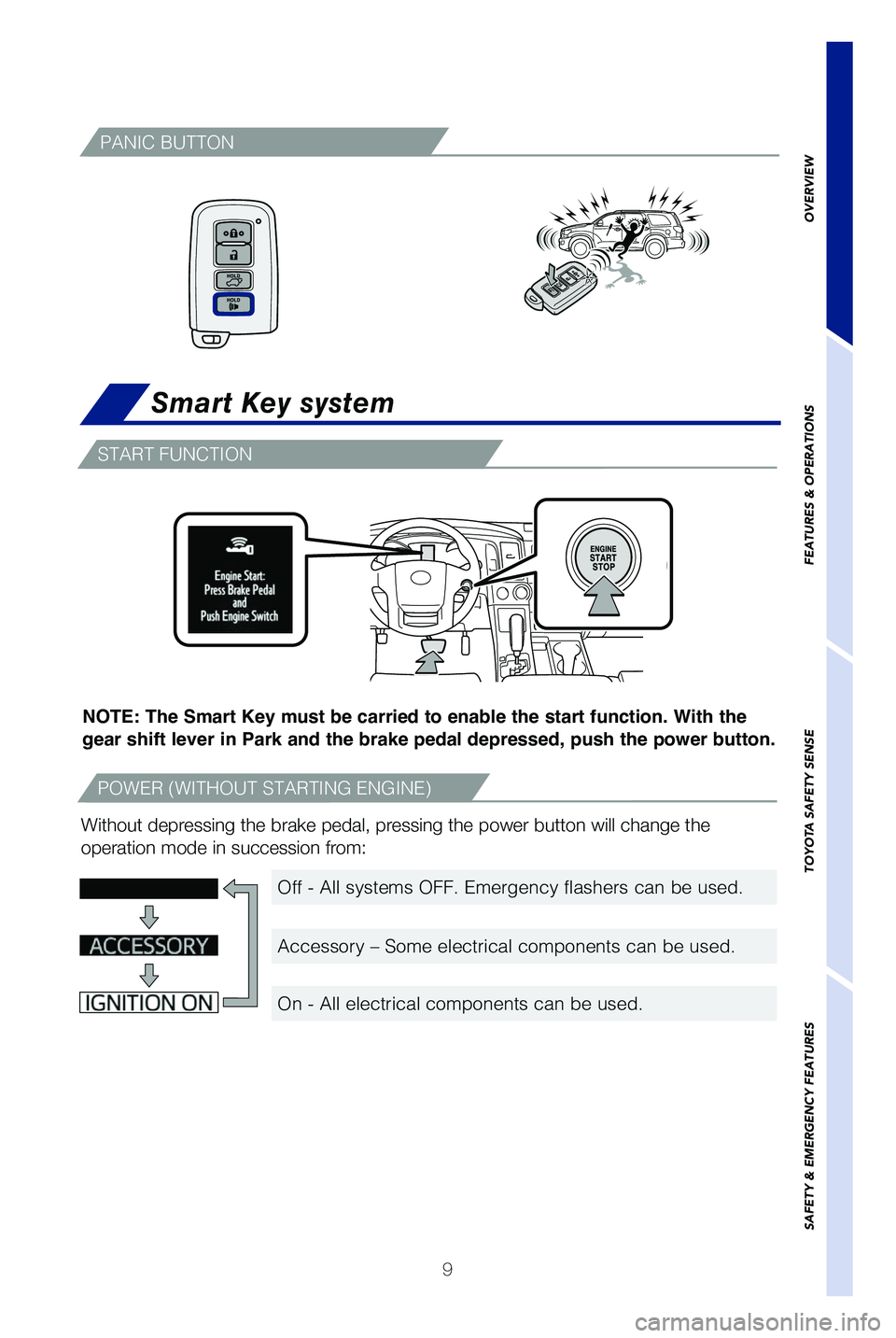
9
OVERVIEW
FEATURES & OPERATIONS
TOYOTA SAFETY SENSE
SAFETY & EMERGENCY FEATURES
PANIC BUTTON
Without depressing the brake pedal, pressing the power button will change the
operation mode in succession from:
POWER (WITHOUT STARTING ENGINE)
START FUNCTION
Smart Key system
NOTE: The Smart Key must be carried to enable the start function. With the
gear shift lever in Park and the brake pedal depressed, push the power button.
Off - All systems OFF. Emergency flashers can be used.
Accessory – Some electrical components can be used.
On - All electrical components can be used.
Page 12 of 59
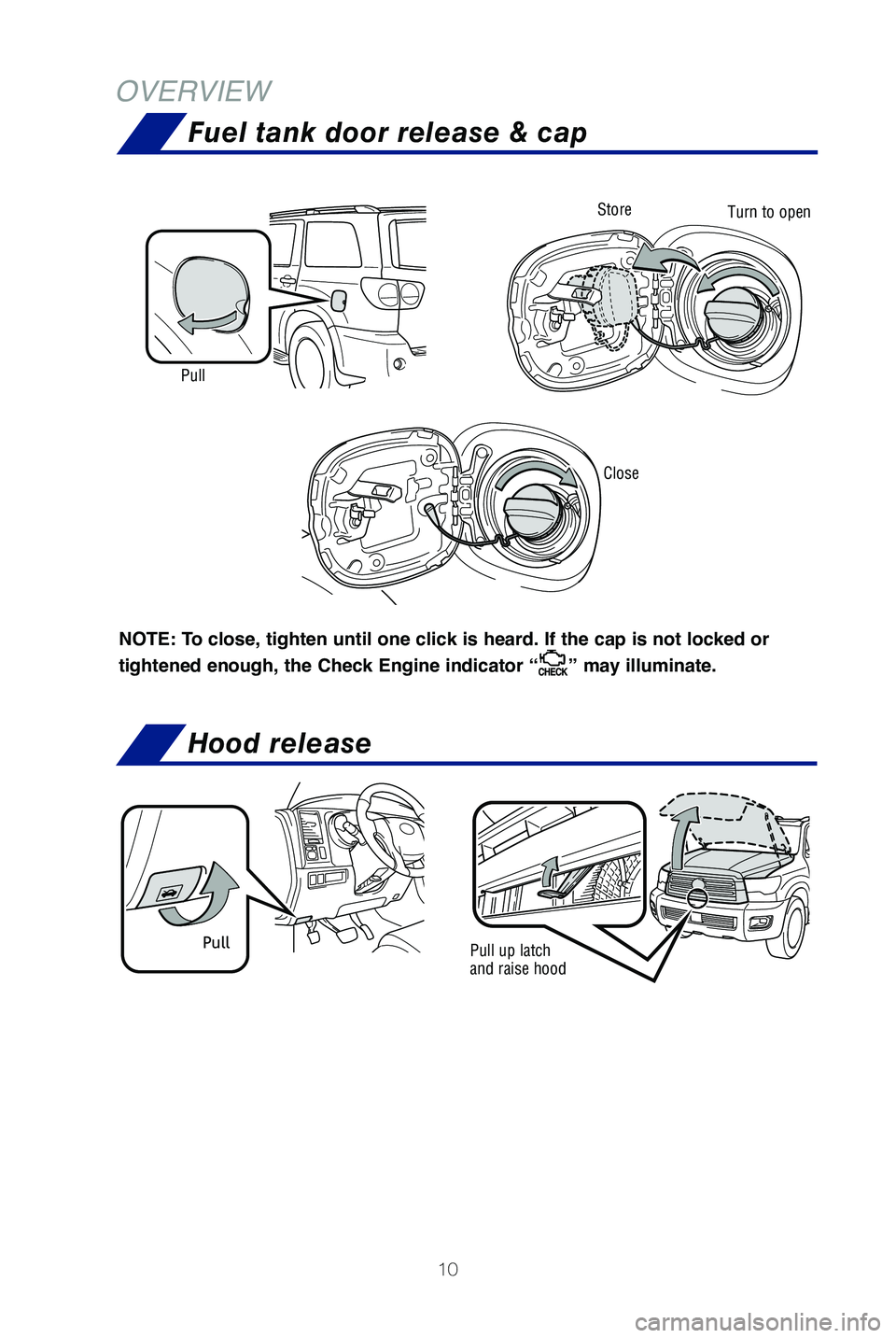
10
OVERVIEW
NOTE: To close, tighten until one click is heard. If the cap is not locked or
tightened enough, the Check Engine indicator “
” may illuminate.
Fuel tank door release & cap
Turn to openStoreClose
Pull
Hood release
Pull up latch
and raise hoodPull
Page 13 of 59
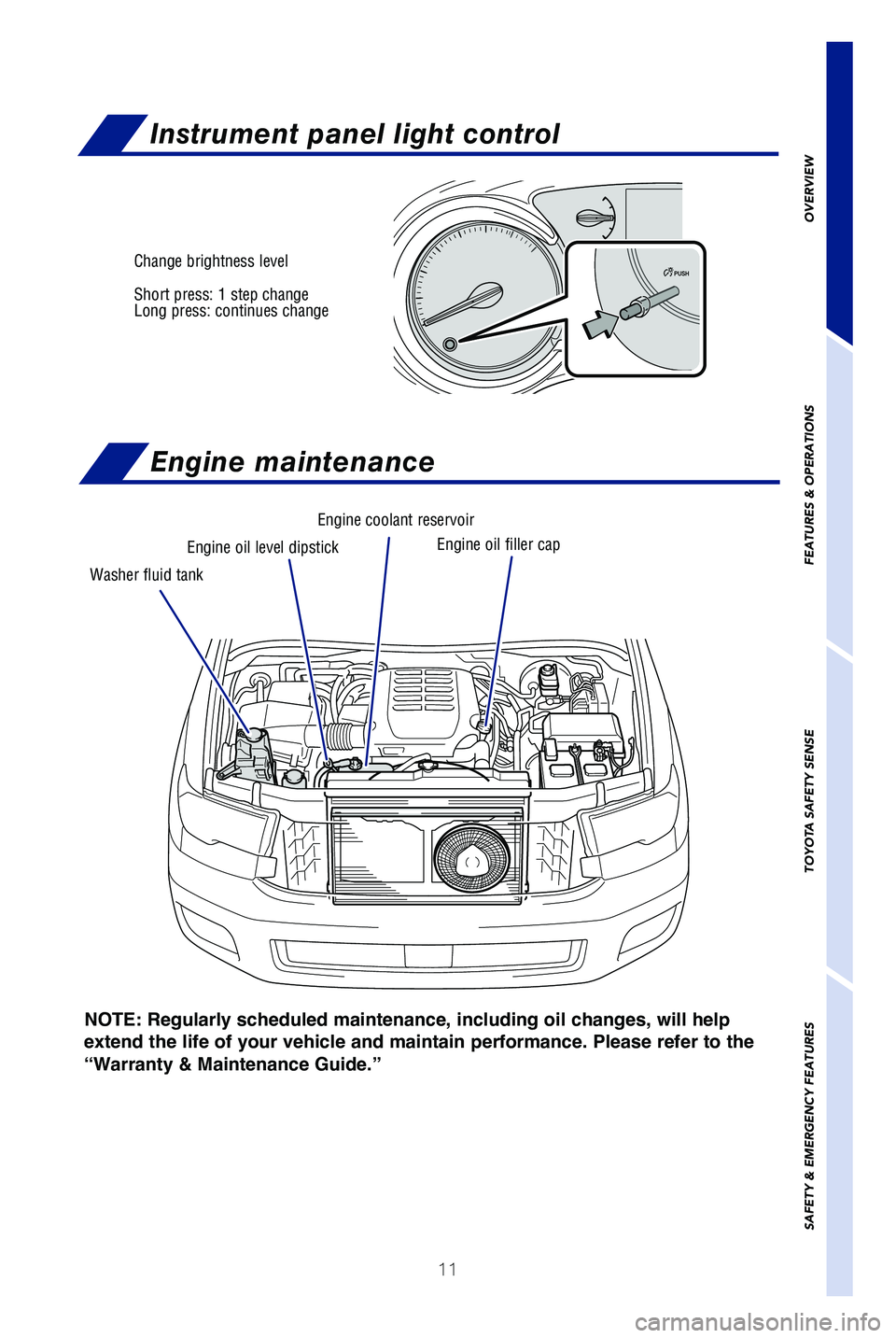
11
NOTE: Regularly scheduled maintenance, including oil changes, will help
extend the life of your vehicle and maintain performance. Please refer to the
“Warranty & Maintenance Guide.”
Engine maintenance
Short press: 1 step change
Long press: continues change Change brightness level
Washer fluid tank Engine oil level dipstick Engine coolant reservoir
Engine oil filler cap
OVERVIEW
FEATURES & OPERATIONS
TOYOTA SAFETY SENSE
SAFETY & EMERGENCY FEATURES
Instrument panel light control
Page 14 of 59
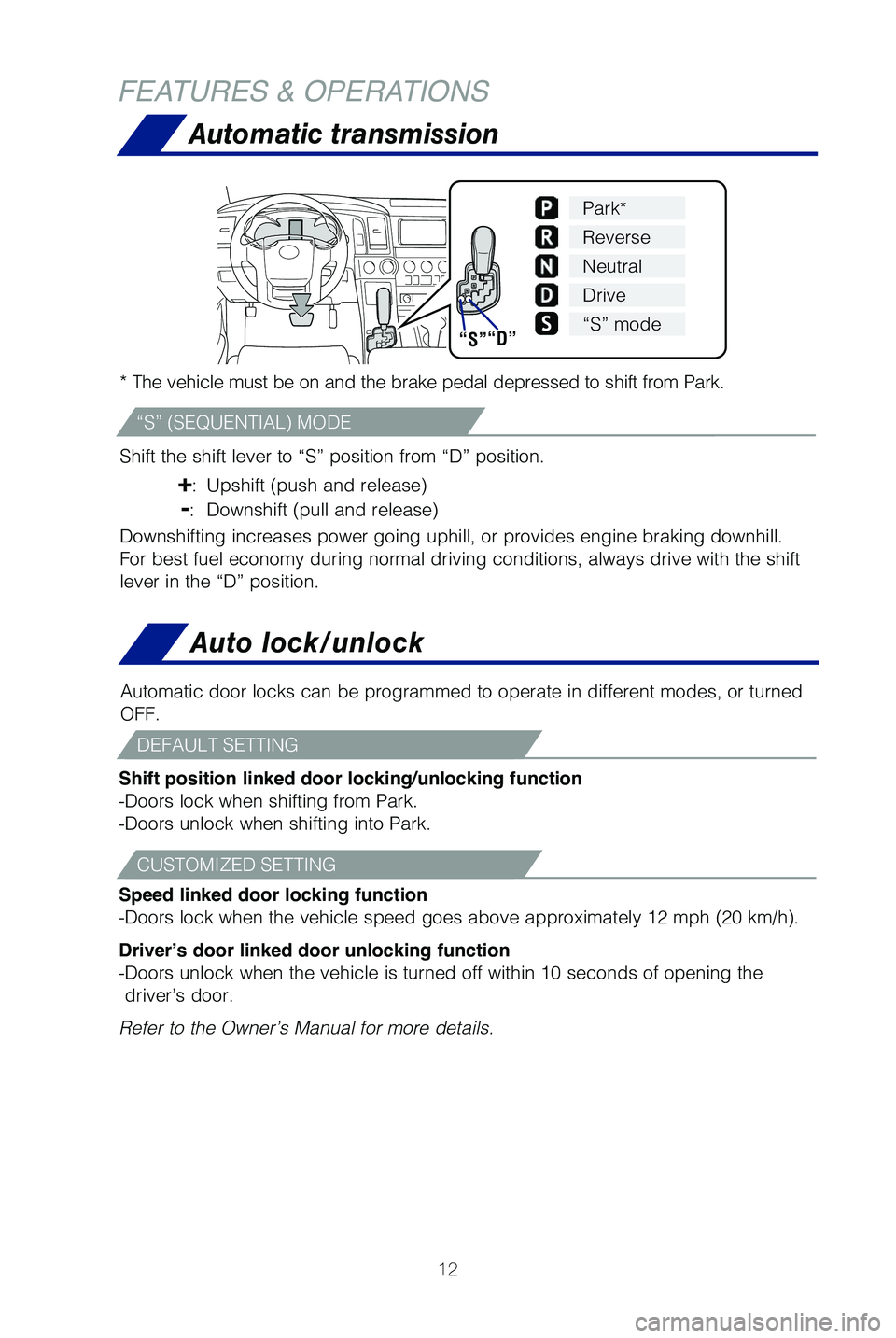
12
FEATURES & OPERATIONSAutomatic transmission
* The vehicle must be on and the brake pedal depressed to shift from Par\
k.
Shift the shift lever to “S” position from “D” position.
+: Upshift (push and release)
-: Downshift (pull and release)
Downshifting increases power going uphill, or provides engine braking do\
wnhill.
For best fuel economy during normal driving conditions, always drive wit\
h the shift
lever in the “D” position.
Park*
Reverse
Neutral
Drive
“S” mode“S”“D”
“S” (SEQUENTIAL) MODE
Auto lock/unlock
Automatic door locks can be programmed to operate in different modes, or\
turned
OFF.
Shift position linked door locking/unlocking function
-Doors lock when shifting from Park.
-Doors unlock when shifting into Park.
Speed linked door locking function
-Doors lock when the vehicle speed goes above approximately 12 mph (20 \
km/h).
Driver’s door linked door unlocking function
-Doors unlock when the vehicle is turned off within 10 seconds of openin\
g the driver’s door.
Refer to the Owner’s Manual for more details.
DEFAULT SETTING
CUSTOMIZED SETTING
Page 34 of 59
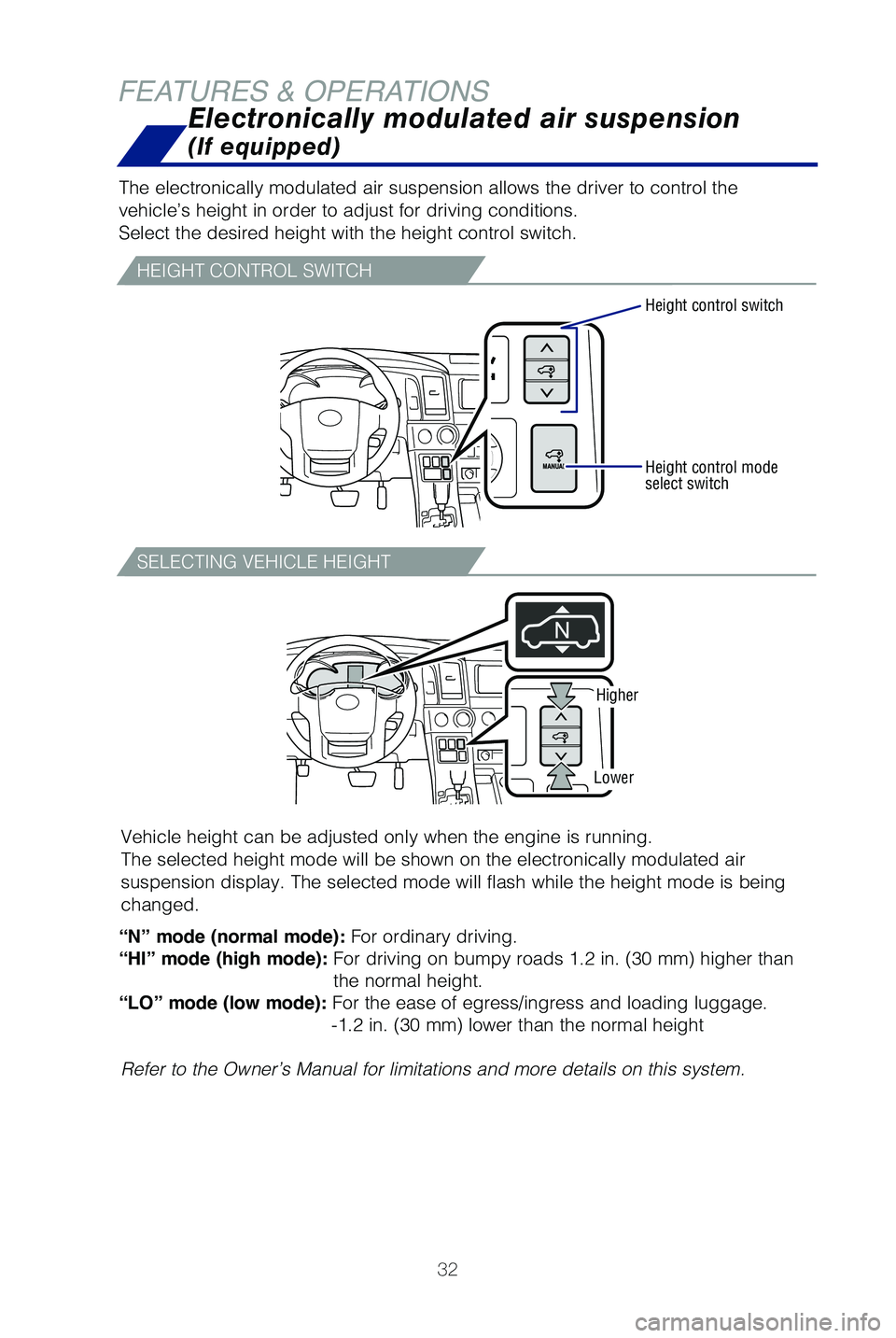
32
FEATURES & OPERATIONS
Electronically modulated air suspension
(If equipped)
The electronically modulated air suspension allows the driver to control\
the
vehicle’s height in order to adjust for driving conditions.
Select the desired height with the height control switch.
“N” mode (normal mode): For ordinary driving.
“HI” mode (high mode): For driving on bumpy roads 1.2 in. (30 mm) higher than
the normal height.
“LO” mode (low mode): For the ease of egress/ingress and loading luggage. -1.2 in. (30 mm) lower than the normal height
Vehicle height can be adjusted only when the engine is running.
The selected height mode will be shown on the electronically modulated a\
ir
suspension display. The selected mode will flash while the height mode i\
s being
changed.
Refer to the Owner’s Manual for limitations and more details on this \
system.
HEIGHT CONTROL SWITCH
SELECTING VEHICLE HEIGHT
Height control switch
Higher
Lower
Height control mode
select switch
Page 47 of 59
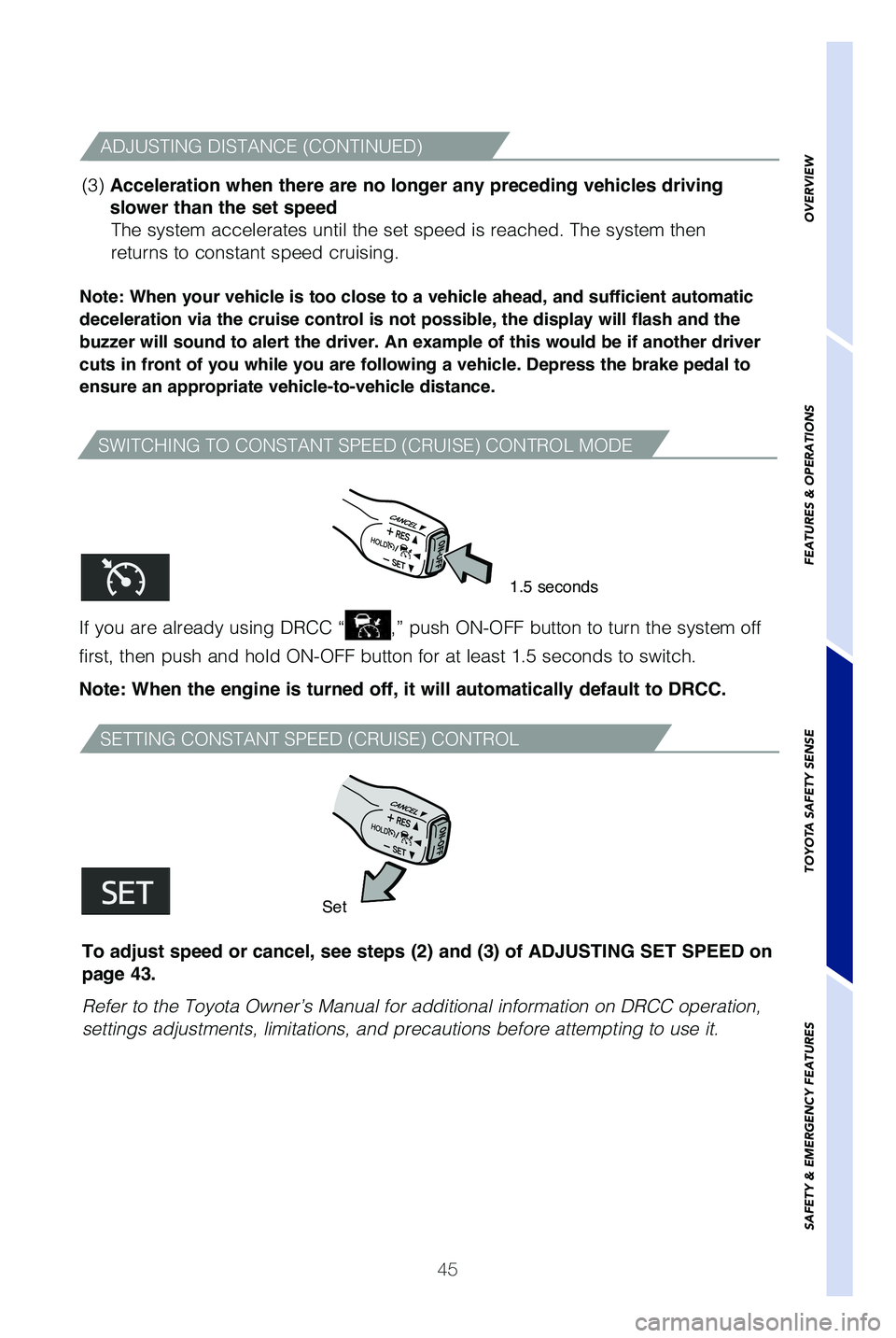
45
OVERVIEW
FEATURES & OPERATIONS
TOYOTA SAFETY SENSE
SAFETY & EMERGENCY FEATURES
SWITCHING TO CONSTANT SPEED (CRUISE) CONTROL MODE
SETTING CONSTANT SPEED (CRUISE) CONTROL
Note: When your vehicle is too close to a vehicle ahead, and sufficient automatic
deceleration via the cruise control is not possible, the display will flash and the
buzzer will sound to alert the driver. An example of this would be if another driver
cuts in front of you while you are following a vehicle. Depress the brake pedal to
ensure an appropriate vehicle-to-vehicle distance.
If you are already using DRCC “,” push ON-OFF button to turn the system off
first, then push and hold ON-OFF button for at least 1.5 seconds to swit\
ch.
Note: When the engine is turned off, it will automatically default to DRCC.
1.5 seconds
Set
(3) Acceleration when there are no longer any preceding vehicles driving
slower than the set speed The system accelerates until the set speed is reached. The system then
returns to constant speed cruising.
To adjust speed or cancel, see steps (2) and (3) of ADJUSTING SET SPEED on
page 43.
Refer to the Toyota Owner’s Manual for additional information on DRCC\
operation,
settings adjustments, limitations, and precautions before attempting to \
use it.
ADJUSTING DISTANCE (CONTINUED)
Page 52 of 59

50
Star Safety System™
Your vehicle comes standard with the Star Safety SystemTM, which combines Anti-
lock Braking System (ABS), Brake Assist (BA), Electronic Brake-force\
Distribution
(EBD), Smart Stop Technology (SST), Traction Control (TRAC) and Ve\
hicle Stability
Control (VSC).
Refer to the Owner’s Manual for more details and important information on limitations
to these systems.
ANTI-LOCK BRAKE SYSTEM (ABS)
Toyota’s ABS sensors detect which wheels are locking up and limits wh\
eel lockup
by “pulsing” each wheel’s brakes independently. Pulsing release\
s brake pressure
repeatedly for fractions of a second. This helps the tires attain the tr\
action that
current road conditions will allow, helping you to stay in directional c\
ontrol.
BRAKE ASSIST (BA)
Brake Assist is designed to detect sudden or “panic” braking, and \
then add braking
pressure to help decrease the vehicle’s stopping distance. When there\
’s only a split
second to react, Brake Assist can add additional brake pressure more qui\
ckly than
just the driver alone can.
ELECTRONIC BRAKE FORCE DISTRIBUTION (EBD)
Toyota’s ABS technology has Electronic Brake-force Distribution (EBD\
) to help
maintain control and balance when braking. EBD responds to sudden stops \
by
redistributing brake force to enhance the braking effectiveness of all f\
our wheels.
SMART STOP TECHNOLOGY (SST)
Smart Stop Technology automatically reduces engine power when the accele\
rator
and brake pedals are pressed simultaneously under certain conditions.
SST engages when the accelerator is depressed first and the brakes are a\
pplied
firmly for longer than one-half second at speeds greater than five miles\
per hour.
SST doesn’t engage if the brake pedal is depressed before the acceler\
ator pedal,
allowing vehicles to start on a steep hill and safely accelerate without\
rolling
backward.
SAFETY & EMERGENCY FEATURES
VEHICLE STABILITY CONTROL (VSC)
VSC helps prevent loss of traction during cornering by reducing engine p\
ower and
applying brake force to selected wheels.
Toyota’s VSC monitors steering angle and the direction your vehicle i\
s traveling.
When it senses that the front or rear wheels begin to lose traction, VSC\
reduces
engine power and applies braking to selected wheels. This helps restore \
traction
and vehicle control.